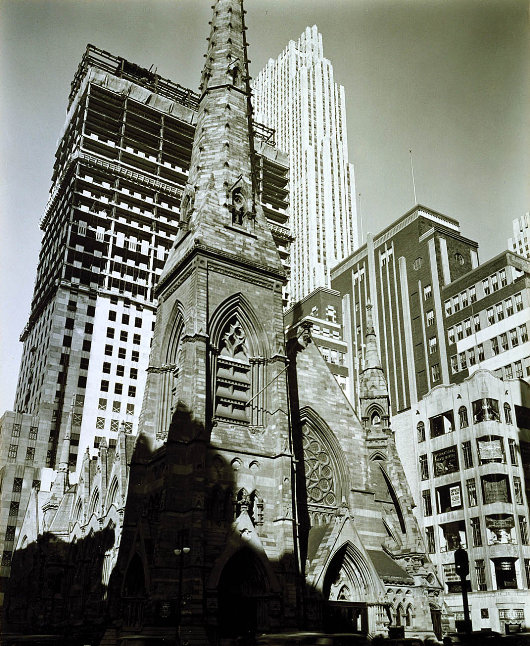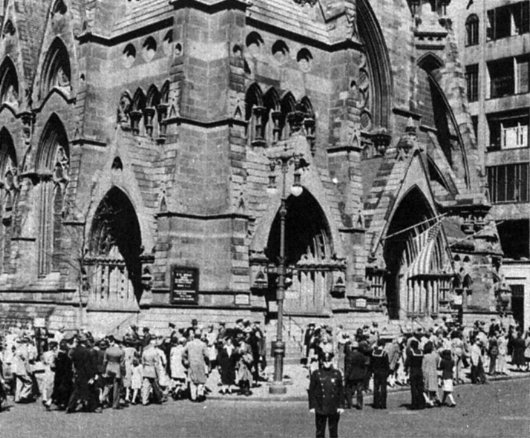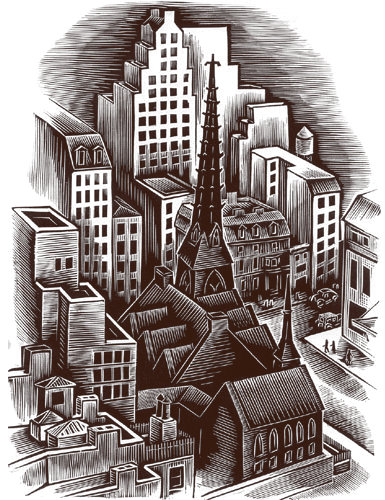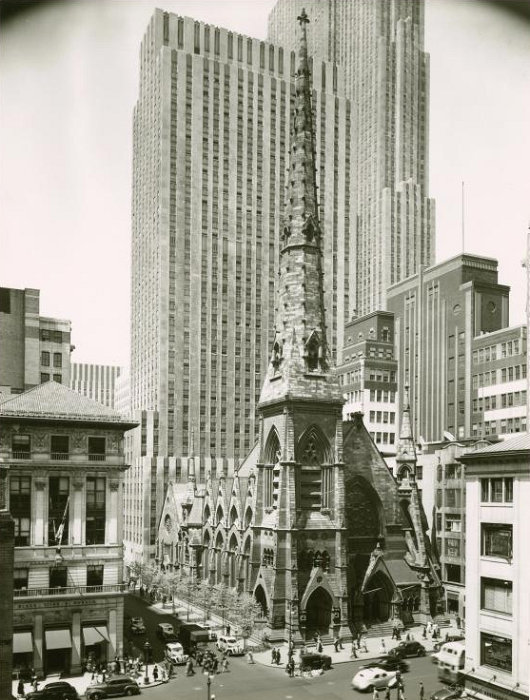
About Andrew Cusack
 Writer, web designer, etc.; born in New York; educated in Argentina, Scotland, and South Africa; now based in London.
Writer, web designer, etc.; born in New York; educated in Argentina, Scotland, and South Africa; now based in London. read more
News
Blogs
Reviews & Periodicals
Arts & Design
World
France
Mitteleuropa
Knickerbockers
Argentina
The Levant
Africa
Cape of Good Hope
Netherlands
Scandinavia
Québec
India
Muscovy
Germany
Academica
New York’s Dutch Cathedral
The Collegiate Church of St. Nicholas, Fifth Avenue

Dedicated a hundred-and-thirty-six years ago, the Collegiate Reformed Protestant Dutch Church of Saint Nicholas on the corner of Forty-eight Street & Fifth Avenue (photographed above by Berenice Abbott) was for many years regarded as the most eminent Protestant church in New York. The Collegiate Reformed Protestant Dutch Church is the oldest corporate body in what is now the United States, having been founded at the bottom of Manhattan in 1628 and receiving its royal charter from William & Mary in 1696. Now part of the Reformed Church of America, the Collegiate Reformed Protestant Dutch Church is actually a denomination within a denomination, and the remaining Collegiate Churches of New York tend to preach a sort of “Christianity Lite”. (The famous Norman Vincent Peale, author of The Power of Positive Thinking and one of the paragons of the “finding a religion that doesn’t interfere with your lifestyle” school of thought, was the pastor of Marble Collegiate Church at Twenty-ninth & Fifth, where Donald Trump is a member of the congregation).

The first regular Calvinist services were held in the loft a grist-mill not long after the foundation of New Amsterdam in 1624. In 1633, Dominie Everardus Bogardus arrived from the Netherlands and built a small wooden church on Broad Street between Bridge and Pearl streets (across from where Fraunces Tavern now stands). This was replaced by stone church of St. Nicholas built inside Fort Amsterdam in 1642 (destroyed by fire in 1741). In 1693, the Dutch congregation moved to a peach orchard on Garden Street (now Exchange Place) where they built a church “by far the most substantial and the finest yet built in Manhattan”. The coats of arms of the church elders (and perhaps of other prominent families) were burnt into the glass windows by Gerardus Duycknick (father of the artist of the same name), and heraldic paintings may have decorate the walls as well. A year later, the members of the congregation sent silver coins to Amsterdam for the casting of a baptismal bowl which was used well into the late nineteenth century. (I wonder where this bowl is now?).
 In 1729, the Collegiate Reformed Protestant Dutch Church erected a second congregation on Nassau Street between Cedar and Crown streets (Crown was renamed Liberty Street after New York became an independent republic in 1783). The bell of the Middle Dutch Church was donated by Col. Abraham de Peyster. North Dutch Church followed in 1769, and Middle Church moved to Lafayette Place in 1844 after their old church was leased to the federal government for use as a post office because of its spaciousness. (Supposedly the king’s army had temporarily converted the building a riding school for the Dragoons during the Revolution). The de Peyster bell was moved from Middle to St. Nicholas after it was dedicated in 1872.
In 1729, the Collegiate Reformed Protestant Dutch Church erected a second congregation on Nassau Street between Cedar and Crown streets (Crown was renamed Liberty Street after New York became an independent republic in 1783). The bell of the Middle Dutch Church was donated by Col. Abraham de Peyster. North Dutch Church followed in 1769, and Middle Church moved to Lafayette Place in 1844 after their old church was leased to the federal government for use as a post office because of its spaciousness. (Supposedly the king’s army had temporarily converted the building a riding school for the Dragoons during the Revolution). The de Peyster bell was moved from Middle to St. Nicholas after it was dedicated in 1872.
The land on which the Church of St. Nicholas stands was purchased from Columbia University in 1857, but it was many years before construction commenced. A lecture room opened for worship services on Christmas Day in 1866, and the cornerstone of the church was finally laid in July 1869. St. Nicholas was the largest of the Collegiate churches and its location on Fifth Avenue attracted many of the well-to-do families of the neighborhood, both of Dutch ancestry and otherwise. (In fact, a letter to the editor of The New York Times was published in May 1896 complaining that, while “there was nothing spared” in the celebrations of the two-hundredth anniversary of the royal charter, “none of the speakers of that evening was in a direct line a descendant from Holland, but rather from France and other foreign countries”). The church was completed in a lively gothic style in a humble Newark sandstone, and with a playfully steeple of exaggerated size. While the presbyterian nature of its Reformed Calvinist polity allows no bishops, because of its scale, social prominence, and location, St. Nicholas was often thought of as “the Protestant Cathedral of New York”.

Regrettably, financial mismanagement forced the Church of St. Nicholas to close its doors in 1947 and the Dutch cathedral of New York demolished in 1949. Just as the independence of India in 1947 presaged the collapse of the British Empire throughout the remainder of the twentieth century, so did the destruction of Saint Nicholas presage the dissolution of the old order in New York. An office building for Sinclair Oil, rather bland yet relatively inoffensive, was constructed in its place and remains there today.
Search
Instagram: @andcusack
Click here for my Instagram photos.Most Recent Posts
- Burns Tower April 19, 2024
- Patrick in Parliament March 18, 2024
- Articles of Note: 13 March 2024 March 13, 2024
- Cambridge March 9, 2024
- Taken on Trust March 4, 2024
Most Recent Comments
Book Wishlist
Monthly Archives
Categories



Another soberly informative post chronicling one more signpost along the sad path of the destruction of what was once the world’s greatest city. Such a sad loss for the city’s premier avenue.
But I am intrigued: what is the daringly avant-garde but nevertheless reasonably elderly building to the right of the church?
That would be the Childs Building, first built in the 1920s as part of the chain of Childs restaurants. (Before Childs, the Russell Sage townhouse was there).
The building was actually designed by William Van Alen, of Chrysler Building fame. Out of respect for St. Nicholas Church, Van Alen treated the side façade with windows rather than giving it the standard Manhattan practice of a blank wall. At the time, the idea that St. Nicholas would be demolished would have been regarded as preposterous.
The Childs building has a column of curved corner windows, and is the first example in Manhattan of this cantilevered element with no corner column. (Much imitated, mostly in postwar apartment buildings).
The building still exists today, with the former Sinclair Oil building built right up against it. The curved corner windows have been replaced with glass brick instead, but the curve is still apparent and it is obvious to the observer who might have no idea about the previous existence of St. Nicholas Church that something is not quite right. The worst thing is that it is now painted in a ghastly shade of sky blue.
Mr Cusack, you are a mine of interesting asnd improving information. I thank you, and i suggest that you should seriously consider writing what would be the definitive book on “Lost New York”.
I heartily second Mr. Van Nostrand’s suggestion. Wonderful and fascinating information. I’ve walked past this corner many times without ever knowing of the prior presence of the Church of St. Nicholas there. Thanks for your diligent efforts, Mr. Cusack. Your readers appreciate it!
I read with great interest your report on St. Nicholas Collegiate Church; but not for the obvious reasons.
What immediately came to mind was the Church of the same name in Galway Ireland (my birthplace and an object of frequent visits).
This St. Nicholas has a rich history, being the last stop of Columbus for Mass before he set out on his voyage.
Cromwell stabled horses there during his reign.
Unfortunely, we never got it back and it’s a C of I church to this day.
Best regards from Michigan.
I am reading a wonderful book “Not Alone” written in 1944 by a minister of St. Nicholas Collegiate Church – Joseph R. Sizoo, DD.
On nearly every page is an important statement I want to save. I’ve tried to find this book on
ABEbooks.com and in some antique book stores to no avail. He must have been a GREAT minister.
My great grandfather, Donald Sage Mackay was the pastor of the Collegiate Church of Saint Nicholas for 10 years, until approximately 1908, the year he died. In a New York Times article on December 12, 1913, reporting on the death of his wife (my great grandmother), Helen Sage Mackay, the journalist states:
“The Rev. Donald Sage Mackay, the husband of Mrs. Mackay, died suddenly on Aug. 27, 1908… During the ten years he served as pastor of the Collegiate Church of St. Nicholas in Fifth Avenue, Col. Theodore Roosevelt was a frequent was a frequent attendant at the services there. While he was president, Col. Roosevelt attended the Rev. Mr. Mackay’s church whenever he was in New York. His death followed a year’s trip abroad taken after his health failed him from overwork.”
The comment of Ms. Drew on a previous pastor’s work reminds me of my ancestor’s sermons compiled into a wonderful book called “The Religion of the Threshold” (The Cambridge Press, 1908).
Should anyone know more about St. Nicholas’ church or my great grandfather and wish to share it, I can be reached at: neideck@gmail.com.
Peter Neidecker
June, 2013
I happened upon this article in trying to find out more about the church where my maternal grandparents were married on Jan. 15 1908: i.e. St. Nicholas Collegiate Church! Before I came across this article I knew nothing about the church except the name; so I’m grateful to find out more about it.
My grandmother had Dutch ancestry going back to Dominie Everardus Bogardus; so it is doubly interesting to see a photo of the church where my grandmother was married; and to learn that its congregation was a lineal descendant of the one where her ancestor preached. In her youth, my grandmother spent summers in upstate NY, staying with Bogardus cousins who farmed there.
By all accounts, both from what I’ve read and also from family lore, Everardus Bogardus was quite a prickly character. An interesting account of the period, which includes sections about Bogardus (not entirely complimentary as I recall), is Russell Shorto’s “The Island at the Center of the World”.
Who can tell me where in which archives the papers of this church are kept?
I believe this fits the description of the church my Dutch parents were married at, in 1944. How can I access more records and verification of this? Who keeps old church records?
Egbert
I presume the records are in the care of the Collegiate Reformed Protestant Dutch Church of New York. Their website can be found here: http://collegiatechurch.org/
I have been searching in vain for pictures of the interior of St. Nicholas Church. The only one I’ve been able to find is after the destruction had already begun. Do you know of any such photos? (As a side note, I am the pastor of the church in Somerville, NJ, where Dr. Sizoo held forth after being at St. Nicholas.)
The Chancel furnishings, Pulpit, Communion Table and Lectern we’re transferred and installed in the Third Reformed Church, Holland, Michigan.